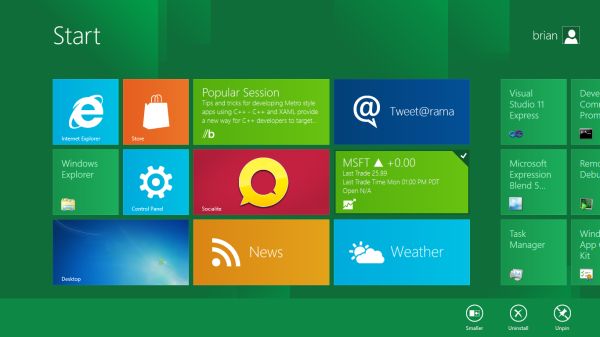Microsoft BUILD: Windows 8, A Pre-Beta Preview
by Brian Klug & Ryan Smith on September 13, 2011 12:05 PM EST- Posted in
- BUILD
- Windows
- Microsoft
- Windows 8
- Trade Shows
We’re here in Anaheim, California at Microsoft’s BUILD conference. As has become tradition (or at least as much as possible), Microsoft has been holding major developer conferences for their new OSes roughly a year ahead of launch. In 2008 developers and the press got their first in-depth look at Windows 7 at Microsoft’s Professional Developers Conference (PDC), and here in 2011 BUILD is doing much the same for Windows 8.
As it stands Windows 8 is still in its infancy. The build in Microsoft’s demos is 1802, a pre-beta and not feature complete version of the OS. Microsoft needs to balance the need to show off Windows 8 to developers with a need to keep it under wraps until it’s done as to not spook end-users. The result of that is the situation at BUILD, where Microsoft is focusing on finished features while unfinished features are either not in the OS or are going unmentioned. For comparison, at PDC 2008 the Windows 7 interface was not done yet, and Microsoft was using the Windows Vista interface in its place.
Today the show kicks off in earnest with a keynote that begins at the same time as this article went live, followed by some mega-sessions for developers covering the biggest aspects of Windows 8. Yesterday was a pre-show day for press, with Microsoft spending most of the day running the press through a similar series of presentations, focused more on the end-user than developers.
At the conclusion of the press sessions we managed to get some hands on time with a tablet PC development platform running the same build of Windows 8. We haven’t had the chance to give the platform a full working over – not that it would be prudent in its pre-beta state – but we did want to give you a rundown of what Microsoft had to share with us and what we’ve seen so far. Microsoft’s tagline for BUILD is that “Windows 8 changes everything” and while Win8 is not a massive reworking of the Windows kernel, it is a major overhaul of nearly everything else. Certainly based on the pre-beta build on display, you will be using Windows 8 significantly differently from Windows 7.
The big thing with Windows 8 is Metro, which we’ll go more in-depth with in a bit. Microsoft classifies Metro as a style, but in reality Metro is a new version of Windows from the API on up. Metro is the Windows Shell, Metro is an application design paradigm, Metro is a user paradigm, and Metro is the future of Windows application programming. Metro is everywhere – and for ARM it is everything - and it will make (or break) Windows 8.











235 Comments
View All Comments
quiksilvr - Tuesday, September 13, 2011 - link
It makes no sense TO* have itGuspaz - Tuesday, September 13, 2011 - link
Well, you can hit Win+D and get the traditional Windows UI... And that illusion of the familiar will last right up until you try to use the start menu to launch something, and get dumped back into Metro. It looks like there's no escaping it.My work machine has two 1280x1024 monitors. 23-point text on these things is going to be enormously huge, it's silly...
alent1234 - Tuesday, September 13, 2011 - link
because most servers have very few applications on them and it's dumb to hide them in the start menu. with the annoying mouse control of KVM switches this may make things a lot easier by using the wasted desktop spaceHMTK - Tuesday, September 13, 2011 - link
I'm pretty sure they'll include it as a Feature on Windows 8 Server for one very good reason: RDS/Citrix.damianrobertjones - Tuesday, September 13, 2011 - link
The users in work will absolutely LOVE this as they prefer things to be EASY TO USERatman6161 - Tuesday, September 13, 2011 - link
At work, for our end users, it is all about the 2 or 3 business applications they use. Go from XP=>Vista=>7=>8 and those couple of apps have not changed. What is so hard about clicking the icon to start the program that they need a big box on their desktop to click on instead of the old style icon. What is to be gained? How is this more EASY TO USE for this group of people?UMADBRO - Tuesday, September 13, 2011 - link
How is it not?Wraith404 - Thursday, September 15, 2011 - link
Users at work won't ever see it, any self respecting system administrator will disable this Metro garbage in group policies.robinthakur - Wednesday, September 14, 2011 - link
Agreed, Windows 7 phone could have been a contender, but everyone MS shopped it to at my old work (who already had iPhones) said it looked far too consumery and passed on the purchase. This is ironic because it integrated perfectly with our SharePoint architecture. They need to have a more corporate version...although I greatly suspect that it's too litle too late.cldudley - Thursday, September 15, 2011 - link
They all have iPhones, and THIS is too consumer-y?